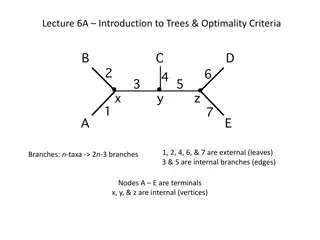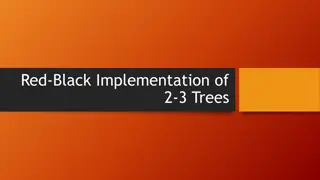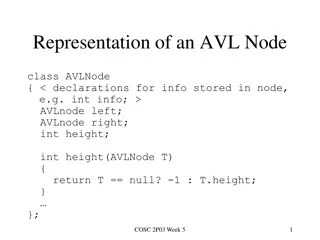Building an Optimization Strategy with Goal Trees
Align your testing efforts with company goals by focusing on impactful tests to achieve quick wins that impact the bottom line. Learn how goal trees map critical metrics and objectives for effective testing and personalization strategies.
Download Presentation

Please find below an Image/Link to download the presentation.
The content on the website is provided AS IS for your information and personal use only. It may not be sold, licensed, or shared on other websites without obtaining consent from the author.If you encounter any issues during the download, it is possible that the publisher has removed the file from their server.
You are allowed to download the files provided on this website for personal or commercial use, subject to the condition that they are used lawfully. All files are the property of their respective owners.
The content on the website is provided AS IS for your information and personal use only. It may not be sold, licensed, or shared on other websites without obtaining consent from the author.
E N D
Presentation Transcript
Goal tree SUBSCRIPTION MODEL When you build an optimization strategy, you ll first align your program s testing efforts to your company goals. We recommend that you start by focusing your program on achieving quick wins with impactful tests that affect the bottom line. A goal tree is a map of metrics that are critical to your company s success. Break each of these metrics down into focused objectives that your program can move the needle on, through testing and personalization. Read this article to learn more about goal trees.
Before you build a goal tree, let s take a look at the structure behind it. Compan y Metric Your company metric measures a high-level goal: an increase in revenue for example. Goal trees help you define the strategic KPIs that your program will optimize through testing and personalization. Each business unit takes a different approach to that metric. For example, the Marketing department might focus on increasing the revenue per visitor (RPV). Business Unit Notice how the company-level metric cascades directly into experiment-level goals. Optimizati on Goals The optimization program breaks down a major KPI such as RPV into more focused targets, such as average order value (AOV). Individual experiments test ways to create lift in the metrics that matter to the program. One might improve the AOV by optimizing the average order quantity, for example. Experiment Goals
EXAMPLE Goal trees break metrics down mathematically. Take a look at a category: Revenue per Visitor, for example. This is the root for two branches: Average Order Value and Conversion Rate. Notice how the branches multiply to equal the root. Average order Value x Conversion Rate = Revenue per Visitor. Revenue: $2.0m Revenue Per Visitor: $1.00 Visitors: 2.0m Use this method to create your own goal tree. Average Order Value: $50.00 Conversion Rate: 2.00% User User retention 33% acquisition: 1.5m Average quantity: 2.00 Average per unit price: $25.00 Cart Checkout Rate Add to Cart
Build your own tree Identify the goal tree that aligns best with your own. Modify it to align it to your own company and program goals. Begin at the top of the tree What does your company do to generate revenue? How does each metric break down into a smaller set of metrics? Remember! Each set of branches should equal the value of the root it springs from.
SaaS EBITDA Revenue EBITDA % Customer Lifetime Value Variable Costs Customers Fixed Costs Monthly Recurring Revenue Customer Lifetime Customer Acquisition User Cost of Goods Sold Retention Acquisition Net Qualified Leads Subscription Rate Deal size Churn Expansion Marketing Mix of sales expansion Lead Lead Generation Qualification
Television & Media Key targets Additional focus areas Future discussion areas Revenue / Visitor Average Order Value Conversion Rate Premium Subscription Revenue Clarity of the purchase process Normal Subscription Product Attractiveness Complexity of buying Number of buying options Product Conversion Rate Product Conversion Rate Increase payment options Product Usability Completion rate per step Users Users Supply Stability Price Competition # of steps
Dating Website Revenue Integration with 300 retail outlets SoulMates.com Revenue Direct online customers to retail outlets Conversion Rate Average Order Value Multi-channel selling Visitors Completion Rate per Step Increase repeat purchases Sustainable churn ratio # of steps Quality Content Reduce checkout funnel length Intuitive navigation Web User Experience Clear Calls to Action Pricing Marketing Distractions Prodauct differentiation Category pages Design Product filters Page speed
Goal mapping Once you identify the KPIs your program will target directly, you ll be able to hypothesize strategies and tactics that make an impact. Use strategies and tactics to create meaningful experiments and campaigns.
Goal Mapping Add to Cart Goals Emphasize the Primary Call to Action Communicate Unique Selling Points Minimize Distractions Design Intuitive Navigation Market Products Effectively Build a Sense of Urgency Strategies Establish a visual hierarchy Select/target the right USP s Use a clear, consistent layout Test ideal product visuals Wording / messaging Show quantity left Structure, naming, and order of sections Remove non- critical content Use the right review systems Push Location / size Refine the messaging Tactics temporary offers Design / color / iconography Find ideal description text / length Promote buying before set times Limit number of choices Communicate visually Use iconography
Goal Mapping Goals Cart Checkout Rate Seamless session continuation across visits Simplifying decision making Funnel path optimization Reducing steps in checkout Personalization Seasonality Strategies Tailor user experience by selected funnel path (search v. browse v. deals) Addressing questions / concerns Targeted offers / content displayed Product selection by season Abandon basket e-mails Skipping upsells Tailor to varying user intent (purchase versus research) Push last item viewed / redirect to conversion step Reduce number of steps in finding and comparing products Messaging + Unique Selling Points adjusted by user segment Reduce pressure of the decision Reduce questions / steps Tactics Redirect users to higher ROI funnel paths Marketing + Imagery per audience Optimize landing pages per season Simplify consultation Push the same product types Pre-fill data























